Last Updated on July 31, 2021
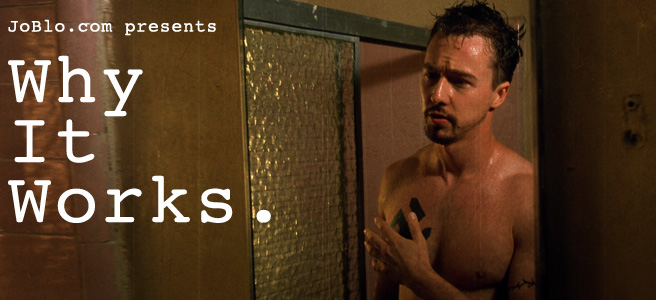 Why It Works is an ongoing column which breaks down some of the most acclaimed films in history and explores what makes them so iconic, groundbreaking, and memorable.
Why It Works is an ongoing column which breaks down some of the most acclaimed films in history and explores what makes them so iconic, groundbreaking, and memorable.
****SPOILERS AHEAD****
Buckle up, kids; this one could get a little bumpy. I count AMERICAN HISTORY X among my favorite films, and yet before preparing for this column, it may have been a decade or so since the last time I sat down with it. Tony Kaye‘s film (or rather not his film, but we’ll get into that later) takes an uncomfortable look at some very nasty people, gives us little in the way of a traditional plot, and leaves us with one hell of a punch to the gut before the credits roll. Here’s why it works:
WHY WE LIKE THE CHARACTERS:
When we first meet Derek Vinyard in the first of the film’s black and white flashback scenes, he is nothing but a hatespeech spewing, arrogant, neo-nazi skinhead. There is no redemption or likability here. Upon his release from prison three years later, however, we see a very clearly changed man, though it’s not until we learn everything he’s been through that we’re able to begin to come around to his side. Derek’s younger brother Danny, on the other hand, is on a reverse trajectory. While he is well on his way to becoming Derek 2.0, we also see that he is still a bit of a blank slate. In many ways, AMERICAN HISTORY X is about the fight for Danny’s soul, with pre-prison Derek, Seth, and Cameron pulling him to the dark side and Dr. Sweeney, his family, and finally post-prison Derek guiding him to the light. Perhaps what lets us even tolerate these characters and their rhetoric is the fact that the film takes time to show us why these people are the way they are. Derek feels anger for the loss of his father, whose death seems to validate the prejudiced views he passed onto his children, and Danny just wants to be like his big brother. To make matters worse, these are intelligent characters with a consistent- albeit warped- logic, which, while difficult to hear, gives a rationale to the characters rather than just making them seem like two-dimensional thugs who want to be bad just for the sake of it.
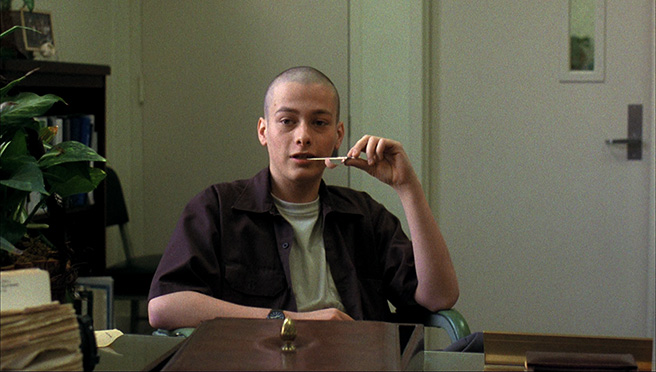 This is what a post-T2 John Connor looks like.
This is what a post-T2 John Connor looks like.
Meanwhile, the film’s unsung heroes come in the form of Danny’s principal, Dr. Sweeney, and Derek’s fellow inmate, Lamont. Rather than hate, fear, or just avoid Derek and Danny altogether, both characters befriend, embrace, and care for them. This not only arguably saves Derek’s life but also gives real, kind, and brilliant faces to a people the brothers Vinyard are so quick to dismiss. Their mother, Doris, and Derek’s history teacher, Mr. Murray, certainly have the same intentions, but Doris tends to let her love for her children become a blind spot, and Mr. Murray finds himself overwhelmed with the situation, convinced Derek has reached the point of no return. Finally, Seth, Stacey, and Cameron remain constant throughout the film, reminding us how closely connected Derek and Danny are to their dark and ugly world.
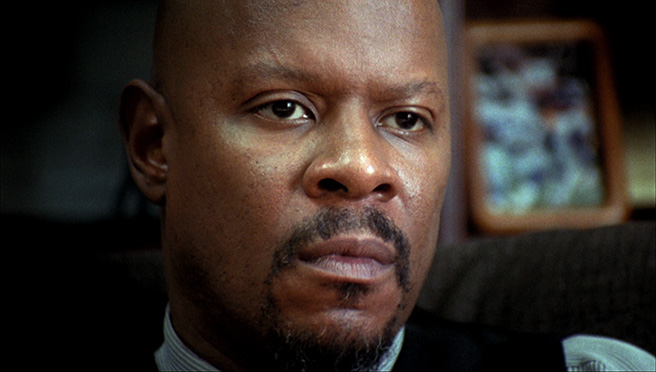 Avery Brooks, come back to Hollywood. We miss you.
Avery Brooks, come back to Hollywood. We miss you.
WHY WE CARE:
Rather than giving us a clear plot to drive the story forward, AMERICAN HISTORY X plays more like a family drama, relying on the interactions of the characters to keep us invested. We also get a sense of mystery as more and more questions are raised by the film. How did Derek become that way? What happened in prison to change him so drastically? What happens now between him and his gang now that he’s reformed? Will he be able to keep Danny from making the same mistakes? The flashbacks serve as the origin story for Derek as we see him first become a villain and gradually work his way toward rehabilitation, while the present day scenes build tension between Derek and his former gang and have us rooting for Danny not to continue down the same path. There’s also a clear undercurrent of tension as both Derek and Danny seek out trouble and find themselves vilified in the process.
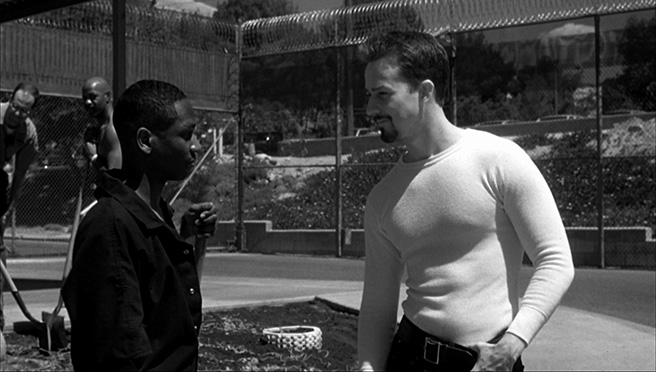 “I’m thinking the only reason I’m getting outta here in one piece is you.”
“I’m thinking the only reason I’m getting outta here in one piece is you.”
WHY WE’RE SATISFIED:
Generally speaking, one of two things will happen to morally corrupt characters in films; they either suffer or learn the error of their ways. Occasionally, however, neither of these is sufficient, and so, by the end of AMERICAN HISTORY X, we get both. Derek is clearly a changed man- he did his time, learned his lesson, and is ready to reenter the world as an honest member of society. On the other hand, letting him simply do his time and move on can send a bit of a weak message, particularly after the horrors we’ve seen him commit. We’re set up to expect Derek to be gunned down in the street, either by members of his former gang or friends of the men he killed. Death is not suffering, though, and so it’s Danny who is instead killed- by a fellow student who meets Danny’s prejudice with hate, no less. Directly, of course, it’s Danny’s actions which cause his demise, but it’s Derek who will have to live with the guilt of knowing his actions and former beliefs helped set Danny’s death in motion. Sure, we’ve seen Derek suffer in prison, but it’s nothing compared to the pain he will have to face for the rest of his life. As we hear the final lines of Danny’s essay, however, it’s clear how much of an impact the new Derek has made on him, and so if nothing else, we can take some solace in knowing Danny Vinyard left the world in peace.
 “We are not enemies but friends. We must not be enemies. Though passion may have strained, it must not break our bonds of affection. The mystic chords of memory will swell when again touched, as surely they will be, by the better angels of our nature.”
“We are not enemies but friends. We must not be enemies. Though passion may have strained, it must not break our bonds of affection. The mystic chords of memory will swell when again touched, as surely they will be, by the better angels of our nature.”
WHY WE REMEMBER:
AMERICAN HISTORY X has a notorious history as a troubled film, with decisions being made without director Tony Kaye, Edward Norton reportedly muscling in on both the script and editing process, and Kaye finally disowning the film and cancelling the premiere, going so far as to try and have his name changed in the credits to Humpty Dumpty. These are usually stories you hear about how a potentially good film became terrible or altogether unreleased, but AMERICAN HISTORY X managed to make it through relatively unscathed, standing tall to this day as one of the many celebrated films of the late 90’s. Edward Norton‘s Oscar nominated performance remains one of his best, as he takes us from a truly upsetting place to a genuinely warm one, Edward Furlong gives us the same duality but from a place of naivete and teenage rebellion, and Avery Brooks, Beverly D’Angelo, Guy Torry, Stacy Keach, Ethan Suplee, Fairuza Balk, Elliott Gould, and Jennifer Lien round out the cast beautifully. David McKenna‘s challenging script provides an organic story and exploration of the characters rather than taking the easy way out, and the alternating black & white and color presentations separate the two timelines both narratively and aesthetically. Finally, whoever ended up shooting, directing, and editing this thing, it looks great and feels both gritty and cinematic without ever going too far in either direction. Someone once said you should end these things with a quote, so I’ll leave you with Tony Kaye in 2012 looking back on AMERICAN HISTORY X and the drama behind its production: “I’m very proud of what we all achieved with AMERICAN HISTORY X. I’m very proud of the performance by Edward Norton, I’m very proud of the performance by Eddie Furlong, I’m very proud of Beverly D’Angelo’s work and Stacy Keach and Avery Brooks. It’s a good film and time is our most precious commodity and always the ultimate judge. It’s still there.”
Thoughts? What else worked for you? What didn’t? Strike back below!
If you have any movies you’d like to see put under the microscope, let us know below or send me an email at brianbitner@joblo.com.



















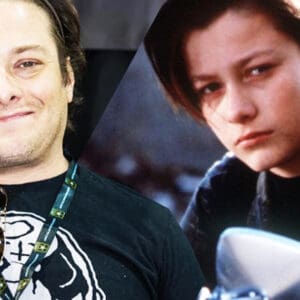




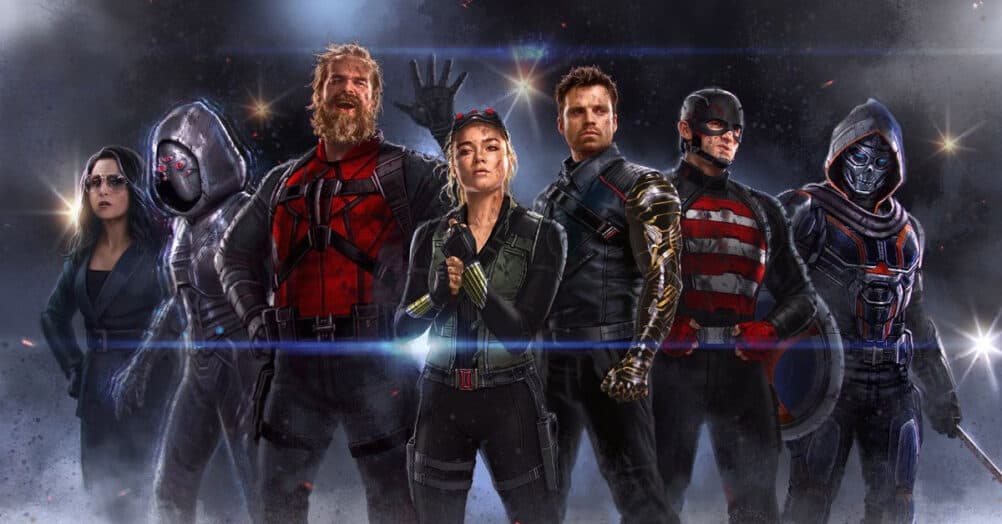









Follow the JOBLO MOVIE NETWORK
Follow us on YOUTUBE
Follow ARROW IN THE HEAD
Follow AITH on YOUTUBE